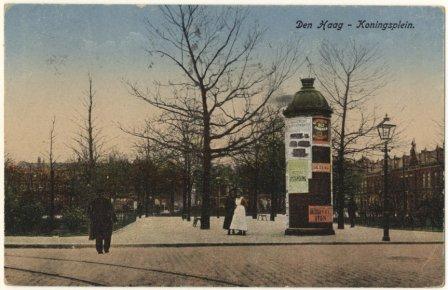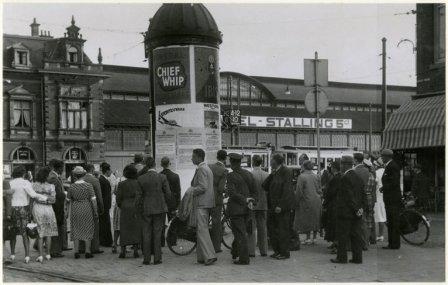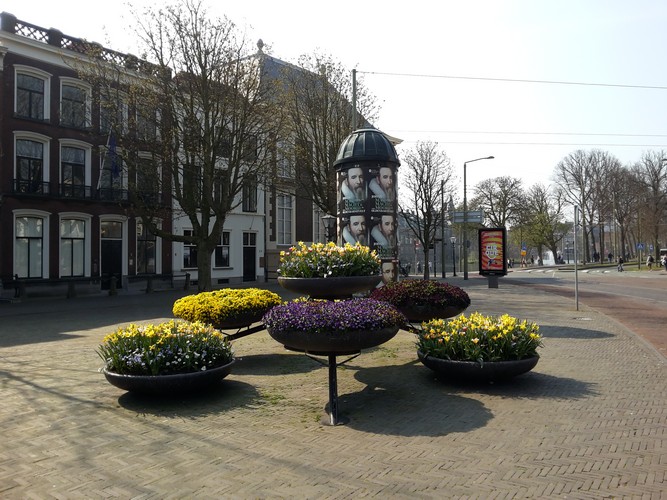It is difficult to imagine our streets without advertising, although it can sometimes become too much. For example, last year in The Hague there was a lot of protest against the placing of illuminated billboards (which were installed non the less). Perhaps it is time to talk about their illustrious predecessors: the transformer columns. The Dutch word is “transformatorzuil”, shortened in common speech to “trafozuil”.
Advertising sprawl
As early as 1854, the German Ernst Litfaß proposed the erection of special columns that would prevent the sprawl of advertising by grouping the advertisements in one place. In the German dictionary you will find the word “Litfaßsäule” as a translation of an advertising column. With the extension of the electricity grid, the columns got a second function. In 1884 the German company “der Berliner Elektrizitätswerke AG” enclosed its transformers in “houses” built in the form of a column. The company rented space on the outside of the column to advertisers, thus generating extra income.
Transformer column
A transformer column is a substation, one of the links between the power plant and the user. The transformer converts high voltage from a power plant into a low voltage suitable for domestic use.
In The Hague the first transformer columns – 53 of them – were installed in 1906, the year in which the municipality started to operate as an electricity supplier. The number of columns then steadily expanded. In 1909 there were 65, in 1919 110, in 1925 151, in 1934 222 and in 1944 228.
Due to their appearance, the transformer columns were also called “pepper shakers”.
Two types
The sheet steel columns came in two different heights.
The most common was a 5,6 meter high model with a diameter of 1,60. The column has three doors, one above the other, allowing maintenance workers to access the transformers. The column is crowned by a so-called count’s crown with fleurons with pearls.
In later years a smaller, shorter model was developed: 4.25 meters high with a diameter of 1.40. And with a simpler and therefore cheaper roof.
World War II
In addition to advertising, the columns could also be used for official announcements. At the outbreak of World War II in September 1939, the government announced the mobilization of the troops. The notification was also posted on the transformer columns of the Municipal Energy Company.
High voltage from 3kV to 10kV
The transformers in the columns were built to convert a high voltage to 3kV. However, in1956 the distribution voltage in the Netherlands was changed from 3kV to 10 kV. But the transformers needed for 10kV were too large to fit in the existing columns and larger “cabins” were built to house the new transformers. And with that, the columns almost completely disappeared from the Dutch street scene. The only function of the transformer column is still as an advertising column for placards.
In The Hague only five well-preserved columns of the high model are left, which fortunately are all on the list of municipal monuments. You can find them on Lange Voorhout, Emmapark, Vondelstraat, Tournooiveld and at the corner Korte Voorhout / Schouwburgstraat.
Transformer cabins
You can also see advertisements on the current transformer cabins. And in the Segbroek neighbourhood in The Hague they have been transformed into beautiful works of art. If you want to see them all, you can build your itinerary using this map
MUPI’s
In January 2019, the first columns with illuminated, and often animated, advertising appeared in The Hague. Such an advertising column is called a MUPI, which stands for Mobilier Urbain Pour l’Information. Because of their size and the places on which they stand, they aroused protest among residents. But the municipality has signed a long-term contract with the French company JCDecaux which involves a lot of money.
The placement of at least 1 MUPI also had consequences for the good, old transformer column. The municipality was of the opinion that on Tournooiveld there was only room for 1 advertising column. Then I would say: “don’t put a MUPI there.” But that is too simple. So shortly after the MUPI appeared, the municipality removed the transformer column. There was much protest, including from yours truly, and with results. The transformer column was reinstalled and is now the friendly neighbour of the MUPI. Old and new coexisting peacefully.
I will show you transformer columns and other street furniture during my city walk.















